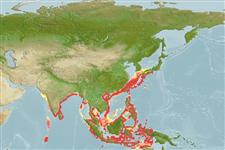>
Eupercaria/misc (Various families in series Eupercaria) >
Nemipteridae (Threadfin breams, Whiptail breams)
Etymology: Parascolopsis: Greek, para in the side of + Greek, skolos = stake + Greek, ops = appearance (Ref. 45335).
More on authors: Temminck & Schlegel.
Environment: milieu / climate zone / depth range / distribution range
Ecologia
marinhas demersal; não migratória; intervalo de profundidade 60 - 131 m (Ref. 9785). Tropical; 36°N - 12°S, 69°E - 136°E (Ref. 3810)
Eastern Indian Ocean: including the Laccadive Islands, Sri Lanka, Andaman Sea. Western Pacific: including southern Japan and the South China Sea.
Tamanho / Peso / Idade
Maturity: Lm ? range ? - ? cm
Max length : 18.0 cm SL macho/indeterminado; (Ref. 3810); common length : 12.0 cm SL macho/indeterminado; (Ref. 3810)
Espinhos dorsais (total) : 10; Raios dorsais moles (total) : 9; Espinhos anais: 3; Raios anais moles: 7. Head scales reaching forward to between middle of eye. Posterior margin of preopercle sloping forward slightly. Lower limb of preopercle naked. Posterior margin of suborbital fine serrate, with a very small spine at upper corner. Pectoral fins long, reaching to or beyond level of anus. Pelvic fins long, reaching to or almost to level of anus. Color: Pale yellowish body, silvery below.
Inhabits sandy or muddy bottoms in offshore waters. Usually in small groups, in depths over 50 m (Ref. 48635). Feeds mainly on benthic invertebrates. Also caught with deep-sea shrimp traps.
Life cycle and mating behavior
Maturidade | Reprodução | Desova | Ovos | Fecundidade | Larvas
Russell, B.C., 1990. FAO Species Catalogue. Vol. 12. Nemipterid fishes of the world. (Threadfin breams, whiptail breams, monocle breams, dwarf monocle breams, and coral breams). Family Nemipteridae. An annotated and illustrated catalogue of nemipterid species known to date. FAO Fish. Synop. 125(12):149p. Rome: FAO. (Ref. 3810)
Categoria na Lista Vermelha da IUCN (Ref. 130435: Version 2024-2)
Ameaça para o homem
Harmless
Utilização humana
Pescarias: pouco comercial
Ferramentas
Relatórios especiais
Descarregue XML
Fontes da internet
Estimates based on models
Preferred temperature (Ref.
123201): 17.8 - 27.4, mean 24 °C (based on 251 cells).
Phylogenetic diversity index (Ref.
82804): PD
50 = 0.5002 [Uniqueness, from 0.5 = low to 2.0 = high].
Bayesian length-weight: a=0.01380 (0.00695 - 0.02741), b=2.96 (2.79 - 3.13), in cm total length, based on LWR estimates for this species & (Sub)family-body (Ref.
93245).
Nível Trófico (Ref.
69278): 3.5 ±0.44 se; based on food items.
Generation time: 1.6 ( na - na) years. Estimated as median ln(3)/K based on 1
growth studies.
Resiliência (Ref.
120179): Elevada, tempo mínimo de duplicação da população menor que 15 meses (K=0.70).
Fishing Vulnerability (Ref.
59153): Low vulnerability (21 of 100).
